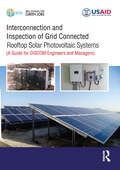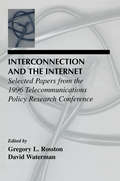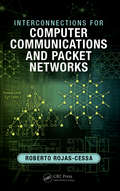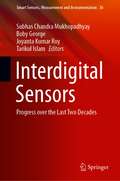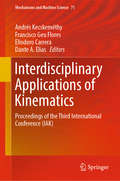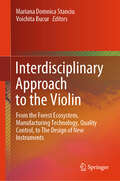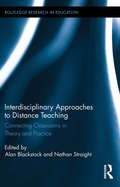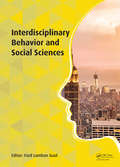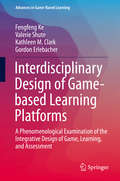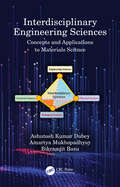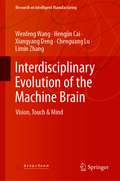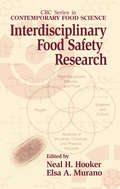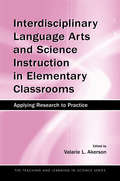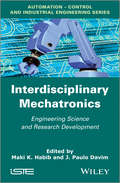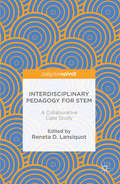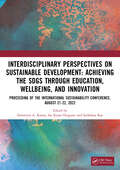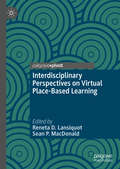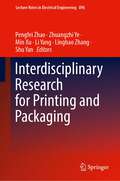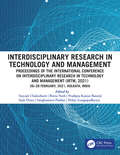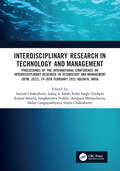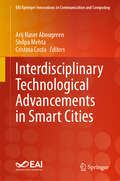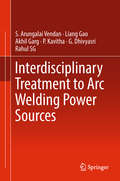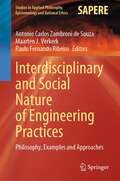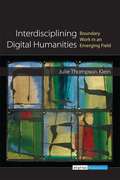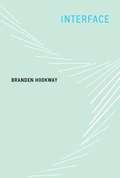- Table View
- List View
Interconnection and Inspection of Grid Connected Rooftop Solar Photovoltaic Systems: A Guide for DISCOM Engineers and Managers
by Tanmay BishnoiThe Government of India is aiming towards a capacity of about 100,000 MW Solar PV power plants by the year 2022. This will involve: 40,000 MW of rooftops 60,000 MW of utility scale ground mount Considering the huge requirement of rooftop solar-grid integration skills to meet this ambitious goal, the Skill Council for Green Jobs is targeting a special skilling course on Interconnection and Inspection of Grid Cnnected Rooftop Solar Photovoltaic Power Plants, which has been declared a National Qualification. This handbook deals with the subject of how an individual can carry out interconnection and inspection of a Rooftop Solar Photovoltaic System, which includes: Pre-commissioning Inspection of the Grid Connected Rooftop Solar Photovoltaic Systems Post-commissioning Inspection of the Grid Connected Rooftop Solar Photovoltaic Systems Maintaining Personal Health and Safety at the Project Site. Distribution companines, Solar Developers and EPC compaines, and other relevant stakeholders have provided their guidance and support in detailing the activities to be performed by the individual who checks, audits, inspects and tests different components of the grid connected Solar Photovoltaic Systems in compliance with all releveante codes, standards, and safety requirements, which has helped in the development of this manual and making it a practical guide.
Interconnection and the Internet: Selected Papers From the 1996 Telecommunications Policy Research Conference (LEA Telecommunications Series)
by Christopher H. Sterling David Waterman Gregory L. RosstonThe Telecommunications Act of 1996 and the Federal Communications Commission's Local Competition Order are just two examples of the continuing monumental and far-reaching changes occurring throughout the telecommunications industry. At the 1996 Telecommunications Policy Research Conference (TPRC) -- an annual forum for dialogue among scholars and the policymaking community on a wide range of telecommunications issues -- leading industry and academic researchers presented results of their research and insights in key areas of activity, including: *interconnection and competition; *Internet growth and commerce; *Internet regulation and control; and *the political economy of telecommunications regulation. The best of the 1996 TPRC papers are included here, representing the forefront of research in the telecommunications industry. The third in an annual LEA series of volumes based on this important conference, this collection reflects the rapid economic, technological, and social development of telecommunications. It also reflects the current state of research thinking on this issue and provides a foundation for further telecommunications policy analysis.
Interconnections for Computer Communications and Packet Networks
by Roberto Rojas-CessaThis book introduces different interconnection networks applied to different systems. Interconnection networks are used to communicate processing units in a multi-processor system, routers in communication networks, and servers in data centers. Queuing techniques are applied to interconnection networks to support a higher utilization of resources. There are different queuing strategies, and these determine not only the performance of the interconnection network, but also the set of requirements to make them work effectively and their cost. Routing algorithms are used to find routes to destinations and directions in what information travels. Additional properties, such as avoiding deadlocks and congestion, are sought. Effective routing algorithms need to be paired up with these networks. The book will introduce the most relevant interconnection networks, queuing strategies, and routing algorithm. It discusses their properties and how these leverage the performance of the whole interconnection system. In addition, the book covers additional topics for memory management and congestion avoidance, used to extract higher performance from the interconnection network.
Interdigital Sensors: Progress over the Last Two Decades (Smart Sensors, Measurement and Instrumentation #36)
by Subhas Chandra Mukhopadhyay Boby George Joyanta Kumar Roy Tarikul IslamThe book highlights the research contributions of the interdigitated (IDT) sensors over a period of two decades in the field of sensing technology. It presents theory, design, and practical realization of the IDT sensors working over wide frequency rage for scientific, industrial, and consumer applications. The IDT sensors have been widely investigated for wide range of sensing applications including agriculture, environmental monitoring, structural health monitoring, health care, food and beverage testing, testing of dielectric material, proximity sensing, microfluidic application, automatic dispensing system etc. Hence, importance of IDT sensors is growing continuously for future applications. As such, it offers a key reference guide on IDT sensors for students, applied physicists, material scientists, engineers, sensors designers and technicians.
Interdisciplinary Applications of Kinematics: Proceedings of the Third International Conference (IAK) (Mechanisms and Machine Science #71)
by Andrés Kecskeméthy Francisco Geu Flores Eliodoro Carrera Dante A. EliasThis is the proceedings of the Third Conference on Interdisciplinary Applications of Kinematics (IAK 2018) held in Lima, Peru, March 5–7, 2018. The conference brought together scientists from several research fields, such as computational kinematics, multibody systems, industrial machines, robotics, biomechanics, mechatronics, computational chemistry, and vibration analysis, and embraced all key aspects of kinematics, namely, theoretical methods, modeling, optimization, experimental validation, industrial applications, and design.Kinematics is an exciting area of computational mechanics and plays a central role in a great variety of fields and industrial applications nowadays. Apart from research in pure kinematics, the field deals with problems of practical relevance that need to be solved in an interdisciplinary manner in order for new technologies to develop.The results presented in this book should be of interest for practicing and research engineers as well as Ph.D. students from the fields of mechanical and electrical engineering, computer science, and computer graphics.
Interdisciplinary Approach to the Violin: From the Forest Ecosystem, Manufacturing Technology, Quality Control, to The Design of New Instruments
by Voichita Bucur Mariana Domnica StanciuThis book can be viewed in many ways as it explores the interdisciplinarity of research in violin engineering and art, being a valuable reference for readers interested in the acoustics of violins and in the science of materials used for making them. In this book, the wood science, the chemistry of varnish, the art and technology of violin making by luthiers and organologic context of violins, are put together giving a holistic view of the subject and complementing the large literature which exists on this instrument. The book is addressed to teachers, researchers, makers of musical instruments and artists alike, this being a good premise for understanding the complexity of the interdisciplinary phenomena that musical instruments involve. This book is based on the material most of which was accumulated during the period 2019-2024, within the ACADIA (61PCE/2022) and MINOVIS (568PED/2020) projects, financial supported by The Executive Unit for the Financing of Higher Education, Research, Development and Innovation from Romania (UEFISCDI).
Interdisciplinary Approaches to Distance Teaching: Connecting Classrooms in Theory and Practice (Routledge Research in Education)
by Nathan Straight Alan BlackstockSynchronous technologies, particularly interactive video conferencing (IVC), are becoming common modes of teaching and delivering college courses. The increasing popularity of IVC in the U.S. and abroad calls for more pedagogically effective practices for instructors using this technology. This volume focuses on innovative and proven approaches to IVC teaching in a variety of disciplines: English, history, biology, chemistry, geology, engineering, social work, and elementary and special education. Contributors hail from a pioneering university at the forefront of distance education and understand the practice and potential of IVC teaching at the highest levels. Chapters outline the challenges and benefits of IVC teaching from pedagogical, technical, and administrative perspectives.
Interdisciplinary Behavior and Social Sciences: Proceedings of the 3rd International Congress on Interdisciplinary Behavior and Social Science 2014 (ICIBSoS 2014), 1-2 November 2014, Bali, Indonesia.
by Ford Lumban GaolThe human aspect plays an important role in the social sciences. The behavior of people has become a vital area of focus in the social sciences as well. Interdisciplinary Behavior and Social Sciences contains papers that were originally presented at the 3rd International Congress on Interdisciplinary Behavior and Social Science 2014 (ICIBSoS 2014),
Interdisciplinary Design of Game-based Learning Platforms: A Phenomenological Examination of the Integrative Design of Game, Learning, and Assessment (Advances in Game-Based Learning)
by Fengfeng Ke Kathleen M. Clark Valerie Shute Gordon ErlebacherThis book represents a four-year research and development project. It presents a phenomenological examination and explanation of a functional design framework for games in education. It furnishes a rich description of the experiences and perceptions of performing interdisciplinary collaborative design among experts of very diverse fields, such as learning systems design, architectural design, assessment design, mathematics education, and scientific computing.
Interdisciplinary Engineering Sciences: Concepts and Applications to Materials Science
by Bikramjit Basu Ashutosh Kumar Dubey Amartya MukhopadhyayInterdisciplinary Engineering Sciences introduces and emphasizes the importance of the interdisciplinary nature of education and research from a materials science perspective. This approach is aimed to promote understanding of the physical, chemical, biological and engineering aspects of any materials science problem. Contents are prepared to maintain the strong background of fundamental engineering disciplines while integrating them with the disciplines of natural science. It presents key concepts and includes case studies on biomedical materials and renewable energy. Aimed at senior undergraduate and graduate students in materials science and other streams of engineering, this book Explores interdisciplinary research aspects in a coherent manner for materials science researchers Presents key concepts of engineering sciences as relevant for materials science in terms of fundamentals and applications Discusses engineering mechanics, biological and physical sciences Includes relevant case studies and examples
Interdisciplinary Evolution of the Machine Brain: Vision, Touch & Mind (Research on Intelligent Manufacturing)
by Wenfeng Wang Xiangyang Deng Limin Zhang Hengjin Cai Chenguang LuThis book seeks to interpret connections between the machine brain, mind and vision in an alternative way and promote future research into the Interdisciplinary Evolution of Machine Brain (IEMB). It gathers novel research on IEMB, and offers readers a step-by-step introduction to the theory and algorithms involved, including data-driven approaches in machine learning, monitoring and understanding visual environments, using process-based perception to expand insights, mechanical manufacturing for remote sensing, reconciled connections between the machine brain, mind and vision, and the interdisciplinary evolution of machine intelligence. This book is intended for researchers, graduate students and engineers in the fields of robotics, Artificial Intelligence and brain science, as well as anyone who wishes to learn the core theory, principles, methods, algorithms, and applications of IEMB.
Interdisciplinary Food Safety Research (Contemporary Food Science)
by Neal H. Hooker Elsa A. MuranoInterdisciplinary Food Safety Research answers the increasing calls to better understand and analyze the impact of food safety efforts. By collecting a wide rage of multidisciplinary examples, the text identifies key areas of research while providing a resource for future group building activities. Written by esteemed authors drawn from the fields of animal science, veterinary science, food science, agricultural economics, and plant pathology, this book serves the dual role of both encouraging comprehensive research by recognizing key early efforts and providing a resource for future group building activities.
Interdisciplinary Language Arts and Science Instruction in Elementary Classrooms: Applying Research to Practice (Teaching And Learning In Science Ser.)
by Valarie L. AkersonThis volume brings together evidence-based approaches to interdisciplinary language arts and science instruction. Firmly grounded in the research showing cognitive parallels between the two subjects, and reflecting the many recommendations in recent years for using interdisciplinary instruction at the elementary level, its goal is to help teachers effectively use this kind of instruction in elementary classrooms. The book is organized around three themes:*Introduction to Interdisciplinary Science and Language Arts Instruction;*The Influence of Interdisciplinary Science and Language Arts Instruction on Children’s Learning; and*Research on Preparing Elementary Teachers to Use Interdisciplinary Science and Language Arts Instruction Each chapter summarizes the research on its focal topic. Examples of research applied to practice, and questions and prompts for discussion and reflection help readers apply what they are reading in their own classroom contexts. Teacher educators and prospective and practicing elementary teachers everywhere will benefit from this overview of current research and practice in interdisciplinary science and language arts instruction.
Interdisciplinary Mechatronics: Engineering Science and Research Development (Wiley-iste Ser.)
by J. Paulo Davim M. K. HabibMechatronics represents a unifying interdisciplinary and intelligent engineering science paradigm that features an interdisciplinary knowledge area and interactions in terms of the ways of work and thinking, practical experiences, and theoretical knowledge. Mechatronics successfully fuses (but is not limited to) mechanics, electrical, electronics, informatics and intelligent systems, intelligent control systems and advanced modeling, intelligent and autonomous robotic systems, optics, smart materials, actuators and biomedical and biomechanics, energy and sustainable development, systems engineering, artificial intelligence, intelligent computer control, computational intelligence, precision engineering and virtual modeling into a unified framework that enhances the design of products and manufacturing processes. Interdisciplinary Mechatronics concerns mastering a multitude of disciplines, technologies, and their interaction, whereas the science of mechatronics concerns the invention and development of new theories, models, concepts and tools in response to new needs evolving from interacting scientific disciplines. The book includes two sections, the first section includes chapters introducing research advances in mechatronics engineering, and the second section includes chapters that reflects the teaching approaches (theoretical, projects, and laboratories) and curriculum development for under- and postgraduate studies. Mechatronics engineering education focuses on producing engineers who can work in a high-technology environment, emphasize real-world hands-on experience, and engage in challenging problems and complex tasks with initiative, innovation and enthusiasm. Contents: 1. Interdisciplinary Mechatronics Engineering Science and the Evolution of Human Friendly and Adaptive Mechatronics, Maki K. Habib. 2. Micro-Nanomechatronics for Biological Cell Analysis and Assembly, Toshio Fukuda, Masahiro Nakajima, Masaru Takeuchi, Tao Yue and Hirotaka Tajima. 3. Biologically Inspired CPG-Based Locomotion Control System of a Biped Robot Using Nonlinear Oscillators with Phase Resetting, Shinya Aoi. 4. Modeling a Human’s Learning Processes toward Continuous Learning Support System, Tomohiro Yamaguchi, Kouki Takemori and Keiki Takadama. 5. PWM Waveform Generation Using Pulse-Type Hardware Neural Networks, Ken Saito, Minami Takato, Yoshifumi Sekine and Fumio Uchikoba. 6. Parallel Wrists: Limb Types, Singularities and New Perspectives, Raffaele Di Gregorio. 7. A Robot-Assisted Rehabilitation System – RehabRoby, Duygun Erol Barkana and Fatih Özkul. 8. MIMO Actuator Force Control of a Parallel Robot for Ankle Rehabilitation, Andrew Mcdaid, Yun Ho Tsoi and Shengquan Xie. 9. Performance Evaluation of a Probe Climber for Maintaining Wire Rope, Akihisa Tabata, Emiko Hara and Yoshio Aoki. 10. Fundamentals on the Use of Shape Memory Alloys in Soft Robotics, Matteo Cianchetti. 11. Tuned Modified Transpose Jacobian Control of Robotic Systems, S. A. A. Moosavian and M. Karimi. 12. Derivative-Free Nonlinear Kalman Filtering for PMSG Sensorless Control, Gerasimos Rigatos, Pierluigi Siano and Nikolaos Zervos. 13. Construction and Control of Parallel Robots, Moharam Habibnejad Korayem, Soleiman Manteghi and Hami Tourajizadeh. 14. A Localization System for Mobile Robot Using Scanning Laser and Ultrasonic Measurement, Kai Liu, Hongbo Li and Zengqi Sun. 15. Building of Open-Structure Wheel-Based Mobile Robotic Platform, Aleksandar Rodic and Ivan Stojkovic. 16. Design and Physical Implementation of Holonomous Mobile Robot–Holbos, Jasmin Velagic, Admir Kaknjo, Faruk Dautovic, Muhidin Hujdur and Nedim Osmic. 17. Advanced Artificial Vision and Mobile Devices for New Applications in Learning, Entertainment and Cultural Heritage Do
Interdisciplinary Pedagogy for STEM
by Reneta D. LansiquotThis book focuses on constructivist theory and collaborative interdisciplinary studies, showing how constructivist theory complements interdisciplinary studies. Constructivist theory stresses how learners construct new ideas and concepts, while the interdisciplinary method requires that learners approach complex problems from multiple perspectives. The author uses the New York City College of Technology as a model to demonstrate how learning can be embedded in complex, realistic, and relevant environments. As a result, students learn to consider significant issues from a variety of viewpoints and thus negotiate their social landscape. In approaching problems that they recognize as meaningful, they take ownership of their learning and become increasingly self-aware. This scholarly book makes a theoretical contribution to its field while also offering a practical, real world example of how to successfully integrate a curriculum.
Interdisciplinary Perspectives on Sustainable Development: Achieving the SDGs through Education, Wellbeing, and Innovation
by Sai Kiran Oruganti Sudeshna Ray Dimitrios A. KarrasISC 2022 is dedicated to the Niti Aayog policies to promote sustainability through exchange of ideas emerging out of the academia. The ISC is an annual conference that is held in virtual mode until COVID restrictions on travel exist. The vision of the conference is to capacitate Academia with the necessary ideas that provide insights of the grassroot level development to various stakeholders of the Niti-Aayog policies. Towards this goal, the conference creates a conjunction of various stakeholders of Niti-Aayog policies that include- academic institutions, government bodies, policy makers and industry. The ISC organizers make concerted efforts to promote academic research that would technological, scientific, management & business practices, and insights into policy merits & disruptions. The framework of exchange of ideas is geared towards adoption of deep technologies, fundamental sciences & engineering, energy research, energy policies, advances in medicine & related case studies. This framework enables the round table discussions between the academia, industry and policy makers through its range of plenary and keynote speakers.
Interdisciplinary Perspectives on Virtual Place-Based Learning
by Reneta D. Lansiquot Sean P. MacDonaldThis book explores how virtual place-based learning and research has been interpreted and incorporated into learning environments both within and across disciplinary perspectives. Contributing authors highlight the ways in which they have employed a variety of methodologies to engage students in the virtual exploration of place. In the process, they focus on the approaches they have used to bring the real world closer through virtual exploration. Chapters examine how the resources of the urban environment have been tapped to design student research projects within the context of an interdisciplinary course. In this way, authors highlight how virtual place-based learning has employed the tools of mapping and data visualization, information literacy, game design, digital storytelling, and the creation of non-fiction VR documentaries. This book makes a valuable contribution to the literature, offering a model of how the study of place can be employed in creative ways to enhance interdisciplinary learning.
Interdisciplinary Research for Printing and Packaging (Lecture Notes in Electrical Engineering #896)
by Min Xu Li Yang Pengfei Zhao Zhuangzhi Ye Shu Yan Linghao ZhangThis book includes original, peer-reviewed research papers from the 12th China Academic Conference on Printing and Packaging (CACPP 2021), held in Beijing, China on November 12-14, 2021. The proceedings cover the recent findings in color science and technology, image processing technology, digital media technology, mechanical and electronic engineering and numerical control, materials and detection, digital process management technology in printing and packaging, and other technologies. As such, the book is of interest to university researchers, R&D engineers and graduate students in the field of graphic arts, packaging, color science, image science, material science, computer science, digital media, network technology, and smart manufacturing technology.
Interdisciplinary Research in Technology and Management: Proceedings of the International Conference on Interdisciplinary Research in Technology and Management (IRTM, 2021), 26-28 February,2021, Kolkata, India
by Satyajit Chakrabarti; Rintu Nath; Pradipta Kumar Banerji; Sujit Datta; Sanghamitra Poddar; Malay GangopadhyayaThe conference on ‘Interdisciplinary Research in Technology and Management” was a bold experiment in deviating from thetraditional approach of conferences which focus on a specific topic or theme. By attempting to bring diverse inter-relatedtopics on a common platform, the conference has sought to answer a long felt need and give a fillip to interdisciplinaryresearch not only within the technology domain but across domains in the management field as well.The spectrum of topics covered in the research papers is too wide to be singled out for specific mention but it isnoteworthy that these papers addressed many important and relevant concerns of the day.
Interdisciplinary Research in Technology and Management: Proceedings of the International Conference on Interdisciplinary Research in Technology and Management (IRTM, 2022), 24-26th February 2022, Kolkata, India
by Satyajit Chakrabarti Rohit Singh Pradipta Kumar Banerji Sanghamitra Poddar Malay Gangopadhyaya Ashiq A. Sakib Anupam Bhattacharya Srijita ChakrabortyWe live in an inter-connected world. In the era of Industry 4.0, technology is getting embedded more and more in the way ‘we learn, live, work, and play’. This progression is accelerating at a pace never seen before. Interdisciplinary and collaborative research across disciplines within the Technology domain and Management domain, and across the Technology-Management interface is opening up exciting new possibilities for solving problems whose solutions are beyond the scope of a single discipline, domain or practice, and helping to create a brave new world. The goal of this conference was to bring together scholars, researchers, consultants, and practitioners to share their interdisciplinary research and consultative work in Technology and Management. Selected papers were then peer-reviewed and authors were invited to present their work in the conference.
Interdisciplinary Technological Advancements in Smart Cities (EAI/Springer Innovations in Communication and Computing)
by Cristina Costa Arij Naser Abougreen Shilpa MehtaThis book explores interdisciplinary technological advancements in smart cities. The book begins with a comprehensive study of smart cities, followed by their benefits and shortcomings. The authors show how, with the help of digital technology, cities are becoming more sustainable and efficient, leading to a better quality of life. The book includes a comprehensive review of literature, research works, and case studies, which are presented to demonstrate how various technologies can be integrated into smart cities. The book includes scenarios in smart agriculture, smart transportation, smart healthcare and more. This book also offers researchers, students, academicians, and professionals working in this field an extensive range of smart city applications.
Interdisciplinary Treatment to Arc Welding Power Sources
by S. Arungalai Vendan Liang Gao Akhil Garg P. Kavitha G. Dhivyasri Rahul SgThis book presents the fundamentals of arc phenomena, various arc welding power sources, their control strategies, welding data acquisition, and welding optimization. In addition, it discusses a broad range of electrical concepts in welding, including power source characteristics, associated parameters, arc welding power source classification, control strategies, data acquisitions techniques, as well as optimization methods. It also offers advice on how to minimize the flaws and improve the efficacy and performance of welds, as well as insights into the mechanical behavior expressed in terms of electromagnetic phenomena, which is rarely addressed. The book provides a comprehensive review of interdisciplinary concepts, offering researchers a wide selection of strategies, parameters, and sequences of operations to choose from.
Interdisciplinary and Social Nature of Engineering Practices: Philosophy, Examples and Approaches (Studies in Applied Philosophy, Epistemology and Rational Ethics #61)
by Paulo Fernando Ribeiro Antonio Carlos Zambroni de Souza Maarten J. VerkerkThis book covers practical and philosophical aspects of Engineering, paying special attention to the social impacts of emerging technologies. Some fundamentals of philosophy of technology are introduced followed by social, economic, and environmental discussion and implications in different disciplines. Each chapter provides insights on the responsibilities involved in the design of engineering projects. The examples presented combine concepts about the impacts of Engineering in society at the same time that incorporates new technological models, yielding an innovative approach about the topics.
Interdisciplining Digital Humanities: Boundary Work In An Emerging Field
by Julie Thompson KleinInterdisciplining Digital Humanities sorts through definitions and patterns of practice over roughly sixty-five years of work, providing an overview for specialists and a general audience alike. It is the only book that tests the widespread claim that Digital Humanities is interdisciplinary. By examining the boundary work of constructing, expanding, and sustaining a new field, it depicts both the ways this new field is being situated within individual domains and dynamic cross-fertilizations that are fostering new relationships across academic boundaries. It also accounts for digital reinvigorations of "public humanities" in cultural heritage institutions of museums, archives, libraries, and community forums.
Interface
by Branden HookwayIn this book, Branden Hookway considers the interface not as technology but as a form of relationship with technology. The interface, Hookway proposes, is at once ubiquitous and hidden from view. It is both the bottleneck through which our relationship to technology must pass and a productive encounter embedded within the use of technology. It is a site of contestation -- between human and machine, between the material and the social, between the political and the technological -- that both defines and elides differences. A virtuoso in multiple disciplines, Hookway offers a theory of the interface that draws on cultural theory, political theory, philosophy, art, architecture, new media, and the history of science and technology. He argues that the theoretical mechanism of the interface offers a powerful approach to questions of the human relationship to technology. Hookway finds the origin of the term interface in nineteenth-century fluid dynamics and traces its migration to thermodynamics, information theory, and cybernetics. He discusses issues of subject formation, agency, power, and control, within contexts that include technology, politics, and the social role of games. He considers the technological augmentation of humans and the human-machine system, discussing notions of embodied intelligence. Hookway views the figure of the subject as both receiver and active producer in processes of subjectification. The interface, he argues, stands in a relation both alien and intimate, vertiginous and orienting to those who cross its threshold.
